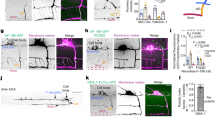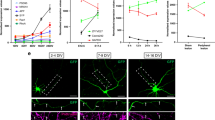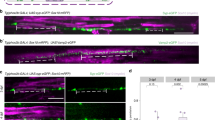Abstract
Axon growth during neural development is highly dependent on both cytoskeletal re-organization and polarized membrane trafficking. Previously, we demonstrated that collapsin response mediator protein-2 (CRMP-2) is critical for specifying axon/dendrite fate and axon growth in cultured hippocampal neurons, possibly by interacting with tubulin heterodimers and promoting microtubule assembly. Here, we identify Numb as a CRMP-2-interacting protein. Numb has been shown to interact with α-adaptin and to be involved in endocytosis. We found that Numb was associated with L1, a neuronal cell adhesion molecule that is endocytosed and recycled at the growth cone, where CRMP-2 and Numb were colocalized. Furthermore, expression of dominant-negative CRMP-2 mutants or knockdown of CRMP-2 message with small-interfering (si) RNA inhibited endocytosis of L1 at axonal growth cones and suppressed axon growth. These results suggest that in addition to regulating microtubule assembly, CRMP-2 is involved in polarized Numb-mediated endocytosis of proteins such as L1.
This is a preview of subscription content, access via your institution
Access options
Subscribe to this journal
Receive 12 print issues and online access
$209.00 per year
only $17.42 per issue
Buy this article
- Purchase on Springer Link
- Instant access to full article PDF
Prices may be subject to local taxes which are calculated during checkout





Similar content being viewed by others
References
Craig, A.M. & Banker, G. Neuronal polarity. Annu. Rev. Neurosci. 17, 267–310 (1994).
Bradke, F. & Dotti, C.G. Establishment of neuronal polarity: lessons from cultured hippocampal neurons. Curr. Opin. Neurobiol. 10, 574–581 (2000).
Fukata, Y., Kimura, T. & Kaibuchi, K. Axon specification in hippocampal neurons. Neurosci. Res. 43, 305–315 (2002).
Goshima, Y., Nakamura, F., Strittmatter, P. & Strittmatter, S.M. Collapsin-induced growth-cone collapse mediated by an intracellular protein related to UNC-33. Nature 376, 509–514 (1995).
Wang, L.H. & Strittmatter, S.M. A family of rat CRMP genes is differentially expressed in the nervous system. J. Neurosci. 16, 6197–6207 (1996).
Inatome, R. et al. Identification of CRAM, a novel unc-33 gene family protein that associates with CRMP3 and protein-tyrosine kinase(s) in the developing rat brain. J. Biol. Chem. 275, 27291–27302 (2000).
Inagaki, N. et al. CRMP-2 induces axons in cultured hippocampal neurons. Nature Neurosci. 4, 781–782 (2001).
Fukata, Y. et al. CRMP-2 binds to tubulin heterodimers to promote microtubule assembly. Nature Cell Biol. 4, 583–591 (2002).
Uemura, T., Shepherd, S. Ackerman, L., Jan, L.Y. & Jan, Y.N. numb, a gene required in determination of cell fate during sensory organ formation in Drosophila embryos. Cell 58, 349–360 (1989).
Rhyu, M.S., Jan, L.Y. & Jan, Y.N. Asymmetric distribution of Numb protein during division of the sensory organ precursor cell confers distinct fates to daughter cells. Cell 76, 477–491 (1994).
Lu, B., Jan, L. & Jan, Y.N. Control of cell division in the nervous system: symmetry and asymmetry. Annu. Rev. Neurosci. 23, 531–556 (2000).
Salcini, A.E. et al. Binding specificity and in vivo targets of the EH domain, a novel protein–protein interaction module. Genes Dev. 11, 2239–2249 (1997).
Santolini, E. et al. Numb is an endocytic protein. J. Cell Biol. 151, 1345–1352 (2000).
Berdnik, D., Török, T., González-Gaitán, M. & Knoblich, J.A. The endocytic protein α-adaptin is required for Numb-mediated asymmetric cell division in Drosophila. Dev. Cell 3, 221–231 (2002).
Owen, D.J. et al. A structural explanation for the binding of multiple ligands by the α-adaptin appendage domain. Cell 97, 805–815 (1999).
Parton, R.G., Simons, K. & Dotti, C.G. Axonal and dendritic endocytic pathways in cultured neurons. J. Cell Biol. 119, 123–137 (1992).
Burack, M.A., Silverman, M.A. & Banker, G. The role of selective transport in neuronal protein sorting. Neuron 26, 465–472 (2000).
Kamiguchi, H. et al. The neural cell adhesion molecule L1 interacts with the AP-2 adaptor and is endocytosed via the clathrin-mediated pathway. J. Neurosci. 18, 5311–5321 (1998).
Kamiguchi, H. & Lemmon, V. Recycling of the cell adhesion molecule L1 in axonal growth cones. J. Neurosci. 20, 3676–3686 (2000).
Kamiguchi, H. & Yoshihara, F. The role of endocytic L1 trafficking in polarized adhesion and migration of nerve growth cones. J. Neurosci. 21, 9194–9203 (2001).
Schaefer, A.W. et al. L1 endocytosis is controlled by a phosphorylation-dephosphorylation cycle stimulated by outside-in signaling by L1. J. Cell Biol. 157, 1223–1232 (2002).
Mishra, S.K. et al. Disabled-2 exhibits the properties of a cargo-selective endocytic clathrin adaptor. EMBO J. 21, 4915–4926 (2002).
Guo, M., Jan, L.Y. & Jan, Y.N. Control of daughter cell fates during asymmetric division: interaction of Numb and Notch. Neuron 17, 27–41 (1996).
Roncarati, R. et al. The γ-secretase-generated intracellular domain of β-amyloid precursor protein binds Numb and inhibits Notch signaling. Proc. Natl Acad. Sci. USA 99, 7102–7107 (2002).
Calderwood, D.A. et al. Integrin β cytoplasmic domain interactions with phosphotyrosine-binding domains: a structural prototype for diversity in integrin signaling. Proc. Natl Acad. Sci. USA 100, 2272–2277 (2003).
Castellani, V., Chedotal, A., Schachner, M., Faivre-Sarrailh, C. & Rougon, G. Analysis of the L1-deficient mouse phenotype reveals cross-talk between Sema3A and L1 signaling pathways in axonal guidance. Neuron 27, 237–249 (2000).
Castellani, V., De Angelis, E., Kenwrick, S. & Rougon, G. Cis and trans interactions of L1 with neuropilin-1 control axonal responses to semaphorin 3A. EMBO J. 21, 6348–6357 (2002).
Arimura, N. et al. Phosphorylation of collapsin response mediator protein-2 by Rho-kinase. Evidence for two separate signaling pathways for growth cone collapse. J. Biol. Chem. 275, 23973–23980 (2000).
James, P., Halladay, J. & Craig, E.A. Genomic libraries and a host strain designed for highly efficient two-hybrid selection in yeast. Genetics 144, 1425–1436 (1996).
Gu, Y., Hamajima, N. & Ihara, Y. Neurofibrillary tangle-associated collapsin response mediator protein-2 (CRMP-2) is highly phosphorylated on Thr-509, Ser-518, and Ser-522. Biochemistry 39, 4267–4275 (2000).
Lemmon, V., Farr, K.L. & Lagenaur, C. L1-mediated axon outgrowth occurs via a homophilic binding mechanism. Neuron 2, 1597–1603 (1989).
Matsuura, Y., Possee, R.D., Overton, H.A. & Bishop, D.H. Baculovirus expression vectors: the requirements for high level expression of proteins, including glycoproteins. J. Gen. Virol. 68, 1233–1250 (1987).
Elbashir, S.M. et al. Duplexes of 21-nucleotide RNAs mediate RNA interference in cultured mammalian cells. Nature 411, 494–498 (2001).
Krichevsky, A.M. & Kosik, K.S. RNAi functions in cultured mammalian neurons. Proc. Natl Acad. Sci. USA 99, 11926–11929 (2002).
Dho, S.E., French, M.B., Woods, S.A. & McGlade, C.J. Characterization of four mammalian Numb protein isoforms. Identification of cytoplasmic and membrane-associated variants of the phosphotyrosine binding domain. J. Biol. Chem. 274, 33097–33104 (1999).
Acknowledgements
We thank Y. Gu, Y. Ihara, A. Craig, M. Nakafuku, A. Tokunaga, H. Okano and V. Lemmon for their kind gifts of materials. We also thank M. Amano, M. Fukata (Nagoya University), H. Qadota and N. Inagaki (Nara Institute of Science and Technology) for their helpful discussions, T. Kimura, T. Shiromizu, H. Watanabe and M. Yoshizaki for preparing some materials and technical assistance, and T. Ishii for secretarial assistance. This research was supported in part by Grants-in-Aid for Scientific Research from the Ministry of Education, Science, Sports and Culture of Japan and the organization for Pharmaceutical Safety and Research.
Author information
Authors and Affiliations
Corresponding author
Ethics declarations
Competing interests
The authors declare no competing financial interests.
Supplementary information
Rights and permissions
About this article
Cite this article
Nishimura, T., Fukata, Y., Kato, K. et al. CRMP-2 regulates polarized Numb-mediated endocytosis for axon growth. Nat Cell Biol 5, 819–826 (2003). https://doi.org/10.1038/ncb1039
Received:
Accepted:
Published:
Issue Date:
DOI: https://doi.org/10.1038/ncb1039
This article is cited by
-
Advances in Understanding the Molecular Mechanisms of Neuronal Polarity
Molecular Neurobiology (2023)
-
Dysregulated CRMP Mediates Circadian Deficits in a Drosophila Model of Fragile X Syndrome
Neuroscience Bulletin (2021)
-
Ketamine Regulates Phosphorylation of CRMP2 To Mediate Dendritic Spine Plasticity
Journal of Molecular Neuroscience (2020)
-
Dysregulation of CRMP2 Post-Translational Modifications Drive Its Pathological Functions
Molecular Neurobiology (2019)
-
CRMPs Function in Neurons and Glial Cells: Potential Therapeutic Targets for Neurodegenerative Diseases and CNS Injury
Molecular Neurobiology (2017)



